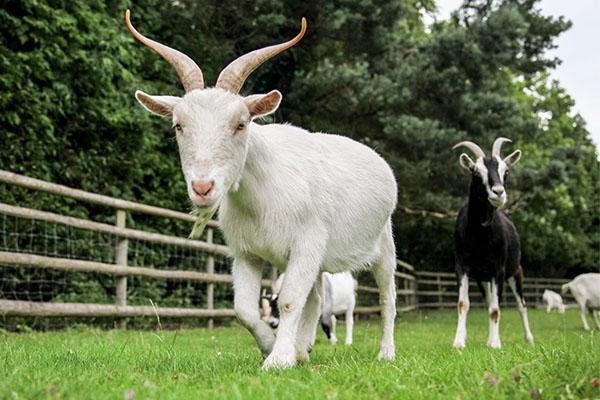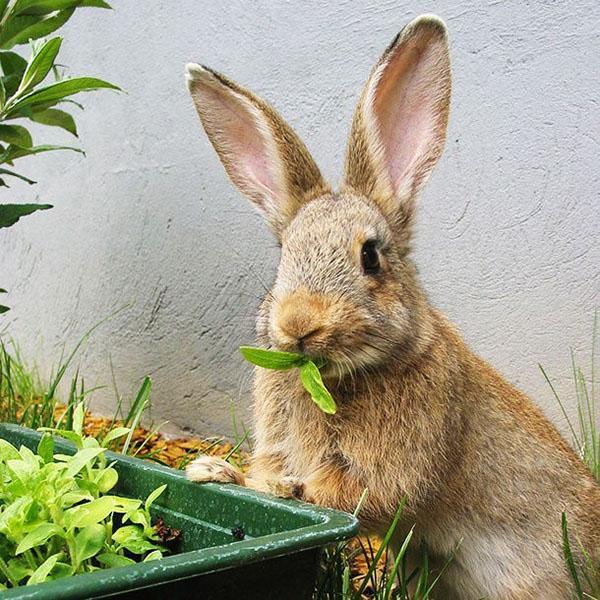Procurement of feed and animal care in August
 Summer is a fertile time for a summer resident keen on breeding poultry, goats, rabbits and other animals. August in the courtyard pleases with growing offspring, milk yield and weight gain, as well as the opportunity to prepare useful food for their pets.
Summer is a fertile time for a summer resident keen on breeding poultry, goats, rabbits and other animals. August in the courtyard pleases with growing offspring, milk yield and weight gain, as well as the opportunity to prepare useful food for their pets.
Goats in the courtyard in August

If during the first attempt the goat is not covered, re-mating is carried out in 2-3 weeks, when the animal comes back to hunt. The favorable period lasts until the end of October. This can be used when there are several goats in the yard. If they give birth alternately, the breeder will have the opportunity to:
- take and feed the replenishment of the herd without haste;
- to maximize the period of obtaining valuable goat milk.
Winter and spring, when the kids appear, are still far away. And in August, goats need attention, which consists in good nutrition and walking. It's still hot during the day, and the goats need an ode. If the pasture has swamps, lakes with stagnant water, puddles remaining after rains, in order to avoid helminthic invasions, it is better to protect animals from drinking from suspicious reservoirs.
On hot days, goats sing twice a day with clean, not cold water. When it gets colder, one watering is enough, for example, in the evening the field returns from the pasture. In the corrals, drinking containers and troughs with salt are also required.
Caring for rabbits in August
 As well as throughout the summer, rabbits receive a lot of green food in August, including:
As well as throughout the summer, rabbits receive a lot of green food in August, including:
- burdock leaves;
- tops of vegetable crops growing in garden beds;
- plantain;
- dandelions;
- fresh meadow grasses and fragrant hay.
The last summer month gives the opportunity to strengthen the immunity of animals. For this, rabbits are released into a fenced area. In the morning hours in such a pen, animals can stay in the sun, which stimulates the absorption of vitamin D. As a preventive measure against coccidiosis in August, rabbits sing with a solution of iodine at the rate of a teaspoon per glass of water.
The middle of the month is the slaughter period for the first litter that appeared this year. At the same time, the females are removed from the grown rabbits of the second brood, and they are transferred to the cages for the young.
It is important to remember that rabbits can only be transferred to clean, disinfected cages. Scrapers are used to remove traces of droppings, and the houses are decontaminated with quicklime. To prevent the spread of chewing lice, lice and other parasites, the outside of the structure is steamed with boiling water or treated with another insecticide.
 The rabbits raised in the summer months are the strongest. They are the best fit for replacing queens and sire males who are already going to retire. Next year, the animals will grow up and will be ready to mate. The selection of males is carried out taking into account related lines. Inbreeding negatively affects litter quality.
The rabbits raised in the summer months are the strongest. They are the best fit for replacing queens and sire males who are already going to retire. Next year, the animals will grow up and will be ready to mate. The selection of males is carried out taking into account related lines. Inbreeding negatively affects litter quality.
The diet of the inhabitants of the farm in August
 The zealous owner of poultry and livestock will never miss the opportunity to prepare food for their pets. August in the summer resident's calendar is the time of the last haymaking.When calculating the amount of hay for the winter, you need to take into account the growth of livestock and the length of the cold season. For example, an adult goat will need about 400 kg of hay, and a young one and a half times less. If you cannot prepare such a volume in August, you can still stock up on brooms and compensate for the shortage with dry foliage.
The zealous owner of poultry and livestock will never miss the opportunity to prepare food for their pets. August in the summer resident's calendar is the time of the last haymaking.When calculating the amount of hay for the winter, you need to take into account the growth of livestock and the length of the cold season. For example, an adult goat will need about 400 kg of hay, and a young one and a half times less. If you cannot prepare such a volume in August, you can still stock up on brooms and compensate for the shortage with dry foliage.
For poultry in August, you can stock flax and hemp seeds. High in protein, fat and fiber, grains increase the activity of birds and improve egg production... If hemp seeds are given without pretreatment, flaxseeds must be steamed and mixed with soft food.
Ripening sunflowers full of black seeds are also a good addition to the bird's diet. They are available, store well, and have the same properties as flax and hemp seeds.
At the end of summer, corn is harvested, which, due to its nutritional properties, is useful in winter, especially in severe frosts. However, feeding grains rich in fats, proteins and carbohydrates should be done carefully so that the feed does not cause obesity. On average, the consumption of corn should not exceed 100 grams per adult bird per day.
The nutritional value of popular poultry grains varies. For example, oats, which have a lot of beneficial qualities, can be given, but be careful because of the coarse, indigestible husk. And barley will give the maximum effect when germinated. On such fattening chicken meat turns out to be especially juicy and tender.
 Garden beds and a garden supply both man and the inhabitants of the courtyard with their fruits. The bird feeds:
Garden beds and a garden supply both man and the inhabitants of the courtyard with their fruits. The bird feeds:
- carrots rich in carotene and other vitamins;
- not much behind her in nutritional value pumpkin;
- zucchini;
- cabbage leaves;
- table and fodder beets;
- turnip;
- small potatoes.
A seasonal addition to the menu in August is a drop of apples and pears, discarded ripe tomatoes, watermelons and melons. It is convenient to give fresh vegetables to laying hens in the summer; for the winter, such feeds are dried or stored in a cool, ventilated place. Sugar beet with high energy value is used as a substitute for grain feed. Boiled potatoes can be given to both adult birds and chickens.